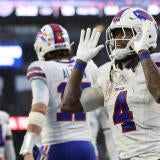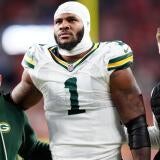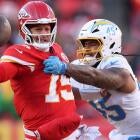Andy Reid acknowledges Clyde Edwards-Helaire isn't perfect, but rookie RB is getting first-team reps anyway
Edwards-Helaire is gearing up for a potentially huge season

When the Kansas City Chiefs spent the No. 32 overall pick in the 2020 NFL Draft in former LSU running back Clyde Edwards-Helaire, football fans, media types, and league observers quickly split themselves into two camps. On one side, there were the people who said you should never spend a first-round pick on a running back. On the other, there were the people who felt the Chiefs needed an upgrade at the position. The ensuing arguments were fairly predictable.
What the two sides agreed on wholeheartedly, though, was the Edwards-Helaire is a perfect fit for Kansas City's offense, and that given a chance in the lead role, he would be an absolute monster. It sure looks like that's shaping up to be exactly how it goes down.
Edwards-Helaire is getting the first-team reps during Chiefs training camp, filling the role vacated by Damien Williams, who opted out of the season due to coronavirus. Asked about Edwards-Helaire at practice, head coach Andy Reid had this to say: "Is everything perfect? No, not right now. But he's working to get there.''
We'll bet on Edwards-Helaire getting there. He's a fantastic talent, the best pass-catching running back in college football last season. And though he is on the small side, he is a strong runner, even between the tackles. And anyway, it's not like Reid has been reluctant to use small backs as clear-cut No. 1 options before. Throughout his career, he has shown a strong preference for having a true feature back.
In his 21 seasons as a head coach, Reid has used what could reasonably be described as a committee backfield only twice in a season where his No. 1 back stayed healthy: in 2003 when he split the work nearly equally between Brian Westbrook and Correll Buckhalter, and last season, when he split the work between Williams and LeSean McCoy, for the most part.
| Year | Team | RB1 | Touches | RB2 | Touches |
| 1999 | Eagles | Duce Staley | 366 | Eric Bieniemy | 14 |
| 2000 | Eagles | Darnell Autry | 136 | Duce Staley* | 104 |
| 2001 | Eagles | Duce Staley | 229 | Correll Buckhalter | 142 |
| 2002 | Eagles | Duce Staley | 320 | Dorsey Levens | 94 |
| 2003 | Eagles | Brian Westbrook | 154 | Correll Buckhalter | 136 |
| 2004 | Eagles | Brian Westbrook | 250 | Dorsey Levens | 103 |
| 2005 | Eagles | Brian Westbrook | 217 | Lamar Gordon | 65 |
| 2006 | Eagles | Brian Westbrook | 317 | Correll Buckhalter | 107 |
| 2007 | Eagles | Brian Westbrook | 368 | Correll Buckhalter | 74 |
| 2008 | Eagles | Brian Westbrook | 287 | Correll Buckhalter | 102 |
| 2009 | Eagles | LeSean McCoy | 195 | Brian Westbrook | 86 |
| 2010 | Eagles | LeSean McCoy | 285 | Jerome Harrison | 48 |
| 2011 | Eagles | LeSean McCoy | 321 | Ronnie Brown | 42 |
| 2012 | Eagles | LeSean McCoy | 254 | Bryce Brown | 128 |
| 2013 | Chiefs | Jamaal Charles | 329 | Knile Davis | 81 |
| 2014 | Chiefs | Jamaal Charles | 246 | Knile Davis | 150 |
| 2015 | Chiefs | Charcandrick West | 180 | Jamaal Charles* | 92 |
| 2016 | Chiefs | Spencer Ware | 247 | Charcandrick West | 116 |
| 2017 | Chiefs | Kareem Hunt | 325 | Charcandrick West | 45 |
| 2018 | Chiefs | Kareem Hunt* | 207 | Damien Williams | 73 |
| 2019 | Chiefs | Damien Williams | 141 | LeSean McCoy | 129 |
| All | Reid | Average | 256 | Average | 92 |
You can see several players on that list that share physical profiles with Edwards-Helaire. There's Westbrook, to whom Reid directly compared the rookie running back during the draft. There's West, who wasn't exactly a big back, either. There's Charles, who became a star under Reid. And there's Bieniemy, the former Eagles running back who is now Kansas City's offensive coordinator, who ran 5-foot-7 and 207 pounds during his playing career -- the exact height and weight at which Edwards-Helaire is listed.
Reid knows exactly what he has in Edwards-Helaire, and he has shown throughout his career that he is both willing to give the lead back role to players like him, and that he knows how to put them in position to succeed. Assuming good health, that's likely exactly what Edwards-Helaire will do.


















